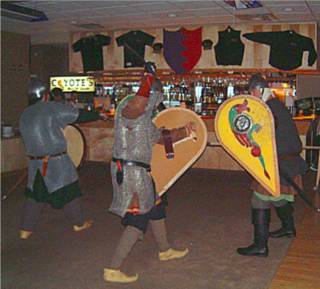Tales of the Middle Ages

Inns appeared in England in the twelfth and thirteenth centuries, and were apparently fairly common, especially in towns, by the fifteenth century. The earliest buildings still standing today, such as New Inn, Gloucester, or King's Head, Aylesbury, date from this time. While inns provided lodgings for travelers, taverns were drinking houses seeking to cater for the more prosperous levels of society. The leading taverners in larger towns were themselves vintners or acted as agents for vintners. The Vintner's Company of London, for instance, secured an essential monopoly of the retail trade in the city in 1364. A tavern of the later Medieval period might be imagined as a fairly substantial building of several rooms and a generous cellar. Taverns had signs to advertise their presence to potential customers, and branches and leaves would be hung over the door to give notice that wine could be purchased. Some taverns sold wine as their only beverage, and a customer could also purchase food brought in from a convenient cook-shop. Taverns seldom offered lodgings or very elaborate feasting, such as would be expected at inns. Pastimes like gambling, singing, and seeking prostitutes were a more common part of the tavern scene.
Huzzah! Pass the mead 'round and fix thine orbs upon this site, tales of woe and cunning abound! Have thee a staunch heart and learn how things were back then. They would consider us all magicians, sayeth Arthur C. Clarke
(Verily, I pluck'd yon link from the depths of bibi's box, forsooth!)
--

0 Comments:
Post a Comment
<< Home